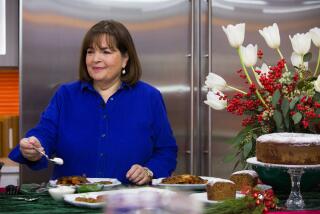Back to nature for our meals
IT has been a remarkable year for books on eating: Marion Nestle’s “What to Eat,” Peter Singer’s “The Way We Eat: Why Our Food Choices Matter,” Michael Pollan’s “The Omnivore’s Dilemma,” Thomas McNamee’s “Alice Waters and Chez Panisse” and Eric Schlosser’s book for teens, “Chew on This.”
All share a distinctly here-are-the-facts-now-you-decide tone, analyzing what we eat through political, sensual, practical, economic and historical lenses. All show how marketing has distorted our choices. And all contend that healthy food isn’t just for the wealthy. As Alice Waters puts it, “food shouldn’t be cheap, and it shouldn’t be fast.” Deciding to pay more and spend more time cooking, turning the Titanic of our lifestyles, is another matter. None of these authors is immune to the difficulties of change -- particularly with children, the most important beneficiaries.
“Animal, Vegetable, Miracle” is Barbara Kingsolver’s chronicle of her family’s one-year “food sabbatical.” Kingsolver, her husband, Steven L. Hopp, and daughters Camille, 19, and Lily, 9, vowed to eat only locally grown, organic food. “We only knew, somewhat abstractly, we were going to spend a year integrating our food choices with our family values, which include both ‘love your neighbor’ and ‘try not to wreck every blooming thing on the planet while you’re here.’ ” The book is written mostly by Kingsolver, but there are several interludes by Camille (who sounds very much like her mother) and a few by Hopp, a biology professor who grew up on the Virginia farm where the family now grows a quarter-acre of fruits and vegetables and raises chickens and turkeys.
The book is interspersed with sections on fuel economy, hunger and nutrition around the world, pesticides and toxins, industrial animal food production and recipes. For example, 400 gallons of oil a year per American are consumed agriculturally. If everyone ate one meal a week of regionally grown, organic food, that would save 1.1 million barrels of oil a week, she writes.
It becomes clear that Kingsolver and her family had long enjoyed the dinner hour together and the meal preparation before making the decision to eat only locally and organically. They were not, in other words, switching from diets high in McDonald’s and white sugar.
They begin their experiment in the spring, when the first asparagus pops up. And much of the book is a pleasant ramble through the seasons on the farm: wild mushrooms, onions, cherries, zucchini, tomatoes (canning, drying, making sauce). Lily is responsible for the roosters, hens and eggs. Not surprisingly, it is extremely labor-intensive, although part of Kingsolver’s point is that this labor brings us closer to nature, closer to the people we love and closer to our community. “I’d say 75 percent of my crucial parenting effort has taken place during or surrounding the time our family convenes for our evening meal.”
Kingsolver acknowledges that some working women may not feel like making homemade mozzarella at the end of the day. They might not be married to a man who likes to make bread. They might not like cooking. “It’s a reasonable position,” she writes. “But it got twisted into a pathological food culture. When my generation of women walked away from the kitchen we were escorted down that path by a profiteering industry that knew a tired, vulnerable marketing target when they saw it.... They threw open the door and we walked into a nutritional crisis and genuinely toxic food supply. If you think toxic is an exaggeration, read the package directions for handling raw chicken.... We came a long way, baby, into bad eating habits and collaterally impaired family dynamics. No matter what else we do or believe, food remains at the center of every culture. Ours now runs on empty calories.”
A working mother may agree with much of this strong language. Kingsolver’s underlying assumption, which may well be true, is that women, whether they work outside the home or not, are primarily responsible for feeding their families. No parent wants to feed children toxic food. So we can go to farmers markets, we can join organic produce delivery clubs and order food online. We can fight the constant battle against the Coca-Colas and Gatorades, the Pop Tarts and hot dogs that “everyone else gets to eat.” We can try to make more money so we can pay not only the baby-sitter and the mortgage but also save a little on the side to buy a few acres someday. Then we can uproot our kids (Kingsolver moved her girls from Arizona to Virginia) and help them learn to live in the country.
We can try.
Therein lies the heartbreaking quality of “Animal, Vegetable, Miracle,” because Kingsolver and her family have already made the leap. Still, it’s a lovely book. One wants with all one’s heart to sit with her on the porch at the end of the day and shell peas.
More to Read
Sign up for our Book Club newsletter
Get the latest news, events and more from the Los Angeles Times Book Club, and help us get L.A. reading and talking.
You may occasionally receive promotional content from the Los Angeles Times.







